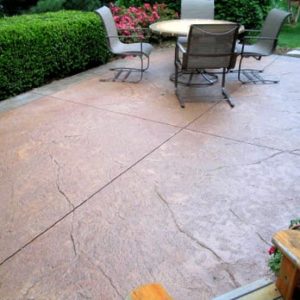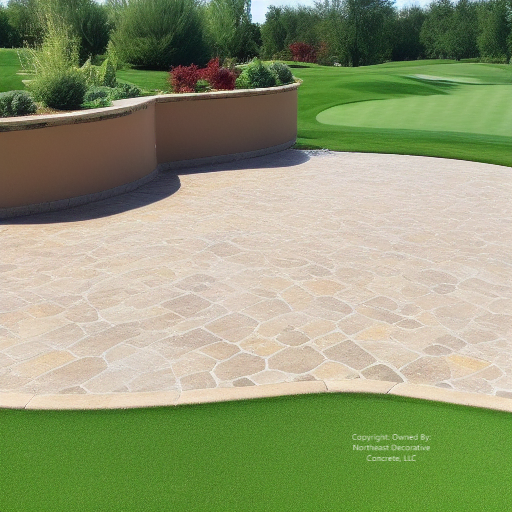
We service all of New Hampshire (NH) , Massachusetts (MA) , and Maine (ME) with Decorative Concrete, Stamped Concrete, Epoxy Floor Coatings, and Garage Flooring. We have a large selection of colors and patterns! Give us a call for your next concrete project. We provide Free Estimates.
How Thick Should Stamped Concrete Be?
When it comes to choosing the thickness of stamped concrete, there are a few factors to consider. The first is the climate. In colder climates, thicker stamped concrete will help keep the surface from freezing. It will also prevent it from becoming brittle. The second consideration is the weight of traffic that will be using the concrete. A thicker stamped surface will be able to withstand more weight. It will not crack or become damaged. The last factor to consider is the overall budget.

How Thick Should Stamped Concrete Be?
Base the thickness of stamped cement on the loads that will be placed on it. The concrete should be thick enough to support the weight of people and vehicles. It should also be thick enough to support the weight of other objects.
The thickness of decorative concrete is an important consideration. It affects the finished look and how long the concrete will last. A thickness of 4 inches is generally recommended. It provides a robust surface that can handle moderate traffic. It also resists staining and fading. But, if you want a more decorative finish or plan to use your stamped concrete in a high-traffic area, you may want to consider a 6-inch thickness.
Factors That Affect the Thickness of Concrete that is Stamped
Many factors affect the thickness of decorative concrete. The size and shape of the stamp, the amount of concrete being poured, and the weather conditions are just a few of the factors. They can influence how thick the concrete should be.
The size and shape of the stamp can affect how thick the concrete needs to be. If the stamp has a lot of details, more concrete will need to be poured. This ensures all the details are covered. The amount of concrete being poured also affects the thickness. If you use more than one layer of concrete, each layer needs a certain thickness. This is to achieve the desired look.
The weather conditions also play a role in how thick the textured concrete should be.
Tips for Creating a Thick Stamping Concrete Surface
When creating a thick, colored, textured concrete surface, keep a few key things in mind. First, you’ll need to make sure that the concrete is poured at the correct thickness. For most projects, a minimum thickness of 4 inches is recommended. This will ensure that the stamping process goes smoothly. It will also make sure the finished surface is both durable and attractive.
In addition, it’s important to use high-quality stamps and tools. If you use cheaper equipment, your stamped concrete surface may not look professional. Finally, be sure to allow enough time for the concrete to dry completely. Only then, apply any sealant or coating. If you try to hurry the process, you may end up with a surface that is uneven or faded.
Benefits of Thick Stamp Concrete
Thick concrete that is stamped can offer a homeowner many benefits. One of the biggest advantages is that it is very sturdy and can withstand a lot of wear and tear. It is also very easy to clean and does not require a lot of maintenance. Thick stamp surfaces can also add value to a home by increasing its curb appeal.
What Else Can You Do to Strengthen The Thickness of Stamping Concrete?
There are a few things homeowners can do to increase the thickness of concrete stamped. One is to add more concrete when the slab is initially poured. This will create a thicker surface that is less likely to crack or chip. Another option is to use a stamping overlay, which is a layer of concrete that is applied over an existing slab. The overlay can be textured or patterned to create the desired look. It will also help to strengthen the underlying surface. In some cases, it may also be necessary to seal the stamped surface. This protects it from weathering and staining.
Why Is Thickness Important for Decorative Concrete?
-Strength
-Durability
-Aesthetics
-Versatility
The thickness of stamp concrete is important because it affects the overall look and feel of the surface. A thicker stamping concrete surface will be more durable and resistant to wear and tear.
- Is Stamped Concrete Worth The Money
- Whats Cheaper Stamped Concrete or Pavers
- How Long Does Stamped Concrete Last
- Is Stamped Concrete Slippery
- How Is Stamped Concrete Installed
- Can Stamped Concrete Be Power Washed
- Is Stamped Concrete Durable
Our Locations:
Nashua, NH
North Hampton, NH
Concord, NH

